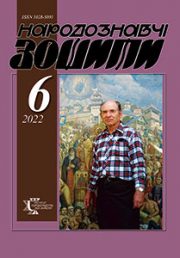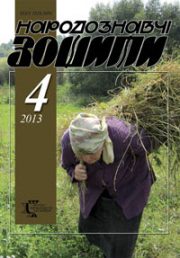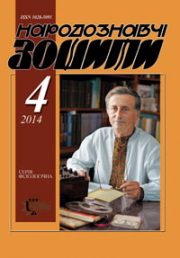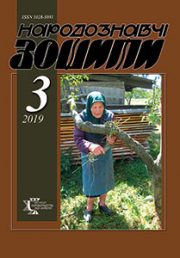The Ethnology Notebooks. 2021. № 4 (160), 909—917
UDK747.023.7(477)
DOI https://doi.org/10.15407/nz2021.04.909
HERII Oksana
- ORCID ID: https://orcid.org/0000-0002-8383-227X
- Ph. D in Art Studies,
- Senior Researcher at the Art Studies Department,
- The Institute of Ethnology of the National
- Academy of Sciences of Ukraine,
- 15, Svobody Avenue, 79000, Lviv, Ukraine.
- Contacts: e-mail: oheriy@ukr.net
Abstract. Introduction. In the last quarter of the 19th century in the artistic life of Western Ukraine arose the question of finding new forms of visual expression of nationally oriented ideas. The art of church interior decorations was not left out of this main trend. The artists had to overcome the inertia of using the motifs of classical ornament and look for other patterns and sources of inspiration to bring their work in line with the new demands of society.
Problem statement. It is necessary to trace the origin and explain the selection of prototypes to create new forms of ornamental paintings in the interiors of Ukrainian churches in Lviv and Ivano-Frankivsk regions, which were made during the last decade of the 19th — the first decade of the 20th centuries.
Methods. For a fuller and deeper understanding of the ornaments creation process in the field of sacred art, we prefer a comparative method among traditional methods of art history research, because this method allows to see changes and differences in more contrast, to evaluate innovations more objectively.
Results. Well-preserved ensembles of the church decoration in the villages of Lviv region (Baryliv, Volya Homuletska, Staryi Vytkiv, Byshiv, Nemyliv, Pidberiztsi) and Ivano-Frankivsk region (Pistyn, Iltsi) are considered. Based on the analysis of their ornaments, it was found that the sources of visual forms in decorative art of the turn of the 19th—20th centuries originate from the Middle Ages and focused mainly on the heritage of illustration of Christian manuscripts of both Churches: Western and Eastern. Rarely samples for new compositions were mosaic motifs taken from the preserved Byzantine monuments of Rome, Ravenna, and Jerusalem.
Сonclusions. Artists of the turn of the 19th—20th centuries used the medieval ornaments as the samples because their origin lay near to the origins of Ukrainian own cultural tradition. It was a necessary step in the process of legitimizing the aesthetic value of newly introduced motifs, which allowed the further flowering of ornament at a new stage of art development — the Art Nouveau style.
Keywords: ornament, church interior, mural, neo-Byzantine style, Secession, Ukrainian modern.
Received 3.08.2021
REFERENCES
- Vdowishevski, J. (1881). Decorative painting with particular regard to local relations. Technical Journal, 7 [in Polish].
- Lachner, F. (1899). Plant ornament in the current art applied to industry. Technical Journal, 23 [in Polish].
- Golubets, M. (1928). One hundred years of Galician painting. The Galician painting (Pp. 23—31). Lviv [in Ukrainian].
- Kupchynska, L. (2009). The Work of Theofil Kopystynsky within the context of the development of the fine arts in western Ukraine during the second half of the 19th and the beginning of the 20th centuries. Lviv; Philadelphia: Religious Society of Ukrainian Catholics «Sofia» [in Ukrainian].
- Sydor, O. (2012). Patriarch Yosyph Slipyi and the Art. Kyiv; Rome: Religious Society of Ukrainian Catholics «Sophia» [in Ukrainian].
- Hrymalyuk, R. (2018). Monumental painting of the second half of the 19th — early 20th centuries. Church art of Ukraine (Vol. 1, pp. 701—744). Kharkiv: Folio [in Ukrainian].
- Studnytska, M., & Studnytsky, R. (2016). Churches of Galicia of the end of the 19th — first third of the 20th centuries: artistic image of the church. Lviv [in Ukrainian].
- Semchyshyn-Huzner, О. (2020). Modest Sosenko (1875—1920). Lviv [in Ukrainian].
- Radomska, V. (2021). Principles of interior organization in Ukrainian sacred architecture of the first quarter of the 20th century (as based on the example of creative works by Modest Sosenko): manuscript. Lviv [in Ukrainian].
- Ripko, O. (1991). Boychuk and Boychukists. Boychukism. Lviv [in Ukrainian].
- Noga, O. (1999). Ukrainian style in the church art of Galicia in the late 19th — early 20th centuries. Lviv: Ukrainian Technologies [in Ukrainian].
- Biriulov, Yu. (2005). Neo-Baroque in Lviv and its Viennese origins (end of the 19th — beginning of the 20th century). Austro-Hungarian Art Culture: The Art of a Multinational Empire. 1867—1918 (Pp. 142—153). St. Petersburg: Aleteiya [in Russian].
- Gordynsky, S. (1989). Ukrainian icon against the background of universalism of the Byzantine style. Scientific Congress of the 1000th anniversary of the baptism of Rus-Ukraine (Pp. 678 — 695). Munich [in Ukrainian].
- Shmagalo, R. (2012). Historical development, structuring and methodology of design education in Ukraine in the late 19th — mid 20th centuries. Essays on the history of Ukrainian design of the twentieth century (Pp. 132—165). Kyiv: Phoenix [in Ukrainian].
- Goriunov, V., & Tubli, M. (1992). Modern architecture. Concepts. Directions. Masters. St. Petersburg: Stroyizdat [in Russian].
- Klimashevsky, A. (2020). Ceramic facade of the city as an autograph of Ivan Levynsky. Ceramic code of Ivan Levynsky in the aesthetic dimension of Ukraine of the late 19th — early 20th centuries (Pp. 94—115). Lviv; Kharkiv: Rarytety Ukrainy [in Ukrainian].
- (1914). Calendar Prosvity. Lviv [in Ukrainian].
- Semchyshyn-Huzner, O. (2017). The History update of the internal space of Holy Resurrection Cathedral in Ivano-Frankivsk (Stanislav) (1897—1904). Bulletin of the Transcarpathian Academy of Arts, 8, 185—190 [in Ukrainian].
- Herii, O., Turkevych-Klimashevsky, A., Kodlubay, I, & Noga, O. (2012). Ukrainian church art 1880—1920 (Western region). Lviv: Ukrainian Technologies [in Ukrainian].
- Korol, S. (2020). Art and industrial exhibitions and the revival of the ceramic industry in Galicia. Ceramic code of Ivan Levynsky in the aesthetic dimension of Ukraine of the late 19th — early 20th centuries (Pp. 22—31). Lviv; Kharkiv: Rarytety Ukrainy [in Ukrainian].
- (1901). Church of the Order of Saint Basil the Great. Zhovkva (Tabl. 2). Architect, 5 [in Polish].
- Nahirny, V. (1905). A few words in the case of church buildings. Dilo, 225, 1, 5 [in Ukrainian].
- Bullen, J.B. (2003). Byzantium Rediscovered. London: Phaidon Press Ltd.
- Nahirny, V. (1935). From my memories. Lviv: Auditing Union of Ukrainian Cooperatives [in Ukrainian].







